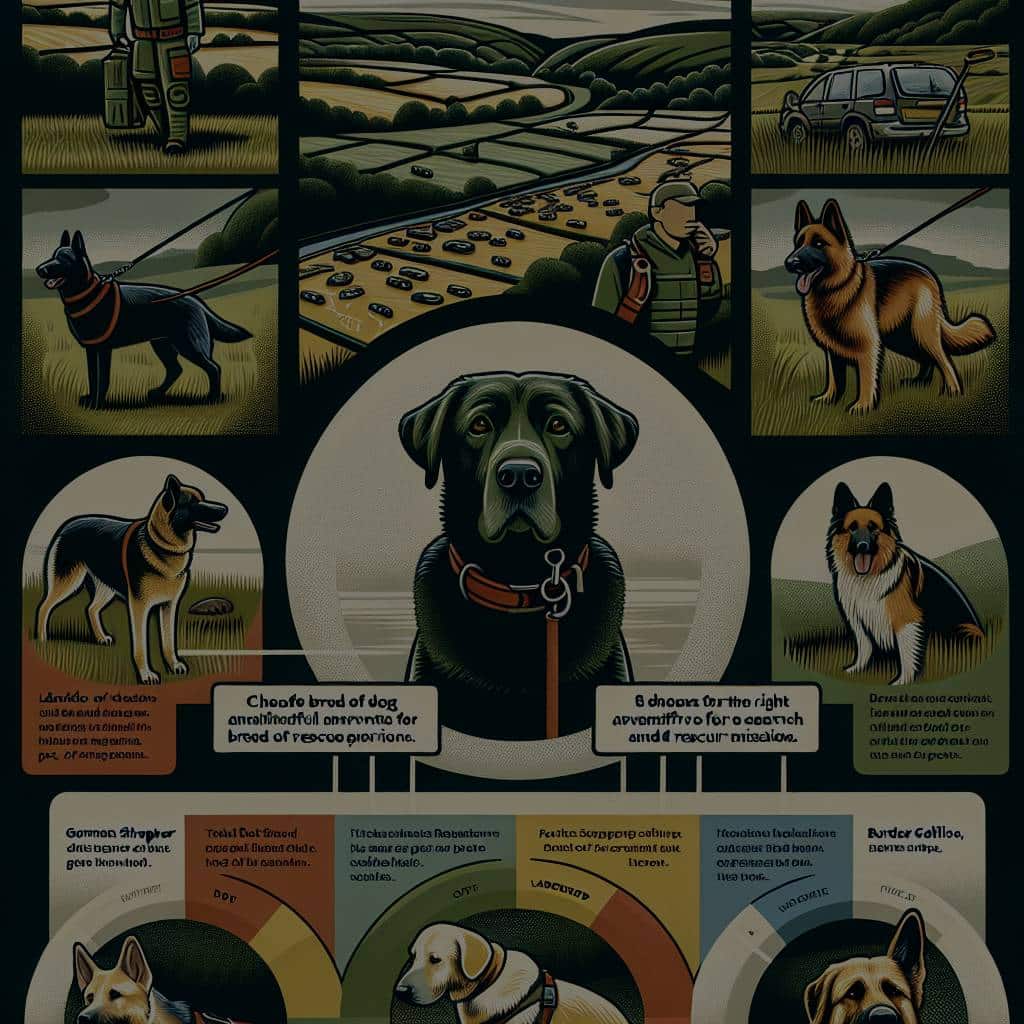How to Choose the Right Breed of Dog for Search and Rescue in Rural Areas?

Searching for lost individuals or items in rural areas is a challenging task. It requires a keen sense of smell, adept navigation skills, and a tenacious spirit. What better way to accomplish these tasks than by employing man’s best friend- the dog? But the question remains, which breed of dog is best suited for such a task? What factors should one consider in training a search and rescue (SAR) dog? This comprehensive guide provides insightful answers to these pertinent questions.
Understanding the Role of Dog Breeds in Search and Rescue
Dogs have been a part of human lives for centuries, aiding in various tasks from herding sheep to providing companionship. However, not all dog breeds are made equal, especially when it comes to search and rescue missions.
Dans le meme genre : What Are the Most Effective Positive Reinforcement Techniques for Horses?
Search and rescue dogs are a special breed. They are trained to find and locate lost individuals or items through scent, typically in rural areas where technology may not be as effective. These dogs play a vital role in emergency situations, especially when time is of the essence.
Choosing the right breed of dog for search and rescue is crucial. But with over 300 breeds recognized by organizations like the American Kennel Club (AKC), making the best choice can be overwhelming. The key is understanding the characteristics and traits that make a breed suitable for this purpose.
Sujet a lire : What Is the Best Material for a DIY Rabbit Hutch That Promotes Good Health?
Traits to Consider When Choosing a SAR Dog Breed
When selecting a SAR dog breed, consider the following traits: endurance, adaptability to weather, intelligence, and trainability. These traits will ensure the dog is well-equipped to handle the physical and mental demands of search and rescue.
Endurance is crucial because a SAR dog will spend hours, possibly even days, searching for lost individuals or items. A breed such as a German Shepherd or a Labrador Retriever is known for its stamina and could be a good choice.
Adaptability to various weather conditions is also important. Dogs like the Border Collie or the Belgian Malinois, known for their weather-resistant coats, can thrive in both hot and cold climates.
Intelligence is another vital trait. Breeds such as the Poodle or the Golden Retriever are known for their sharp minds, making them quick to learn and adapt to new commands.
Lastly, consider the breed’s trainability. Breeds like the Border Collie or the German Shepherd are known to be highly trainable, making them ideal candidates for the rigorous training a SAR dog undergoes.
Top Breeds for Search and Rescue in Rural Areas
Here are a few breeds, with images, that are considered top choices for search and rescue in rural areas due to their inherent traits and capabilities.
-
German Shepherds: Known for their intelligence and adaptability, German Shepherds are a popular choice for SAR. They have a keen sense of smell and can work for extended periods. Their agility and strength make them well-suited for rural terrain.
-
Labrador Retrievers: Labradors have an incredible work ethic, making them ideal for SAR. They are trainable, intelligent, and have a strong sense of smell. Their water-resistant fur allows them to work well in wet weather conditions.
-
Border Collies: Renowned for their intelligence and agility, Border Collies can navigate the tricky terrains of rural areas. They are also highly trainable and have good endurance.
-
Belgian Malinois: Similar to German Shepherds in many respects, Belgian Malinois are known for their sharp minds, adaptability, and endurance. They are also very trainable and have a keen sense of smell.
The Importance of Training for Search and Rescue Dogs
Even with the right breed, training is crucial to prepare a dog for search and rescue work. Training not only involves teaching the dog how to find lost individuals or items but also how to navigate various terrains, work in different weather conditions, and manage long working hours.
Training should start when the dog is still a puppy, ideally around 7-8 weeks old. This is the best time to start socializing the dog and introducing basic commands. As the dog grows older, more complex tasks such as tracking and obedience can be introduced.
A crucial part of SAR dog training is scent work. This involves teaching the dog to use its sense of smell to find people or objects. This training can be complex and time-consuming, but it’s absolutely critical for a successful search and rescue dog.
Choosing the right breed of dog for search and rescue in rural areas can be a challenging task. The dog’s breed, traits, and training all play a crucial role in its ability to perform effectively. By considering these factors carefully, you’ll be well on your way to finding an effective SAR dog.
Choosing the Right Breeds for SAR: Mixed Breeds and Lesser-Known Varieties
While the German Shepherd, Labrador Retriever, Border Collie, and Belgian Malinois are well-regarded for their SAR capabilities, it’s essential to remember that other breeds and even mixed breeds may also be suitable for this role. A dog’s ability in search and rescue is not determined by its breed alone, but a combination of its individual traits, temperament, and training.
Mixed breed dogs can make excellent SAR dogs. They often combine the best traits of different breeds, making them intelligent, adaptable, and trainable. Some mixed breed dogs, especially those featuring breeds known for their SAR abilities like the aforementioned, can prove to be excellent choices.
In the realm of lesser-known breeds, Bloodhounds are worth considering. They have been originally bred for tracking and have an exceptional sense of smell. This, combined with their endurance and determination, makes them outstanding SAR dogs.
Among the working dog family, Newfoundland dogs are highly prized for their strength, endurance, and excellent swimming abilities. Their innate rescue instincts make them a strong contender for water-based search and rescue operations.
Remember, the right dog for SAR in rural areas is not necessarily the most well-known or popular breed but the one that best suits the unique demands of search and rescue work.
Conclusion: The Journey Towards the Best SAR Dog
Choosing the right dog for search and rescue in rural areas is a careful balancing act between selecting the right breed and providing them with comprehensive training. While breeds like the German Shepherd, Labrador Retriever, Border Collie, and Belgian Malinois are well known for their abilities, don’t overlook the potential in mixed breeds and lesser-known varieties like the Bloodhound and Newfoundland.
Training is equally important. A well-trained dog, regardless of its breed, can outperform a poorly trained one. Starting as early as 7-8 weeks old, the dog should be introduced to basic commands, socialization, and gradually more complex tasks. Special attention must be given to scent work, which forms the crux of a SAR dog’s duty.
Ultimately, the right dog for search and rescue is one that is not only of the right breed but also properly trained and well-adjusted to the challenging and rewarding work of saving lives. The journey to find and train the best SAR dog may be challenging, but it’s a journey worth embarking upon. The result will be a four-legged hero, ready and able to serve when the need arises.
Always remember, with the right breed selection and comprehensive training, the perfect search and rescue canine could well be at the end of your leash.
